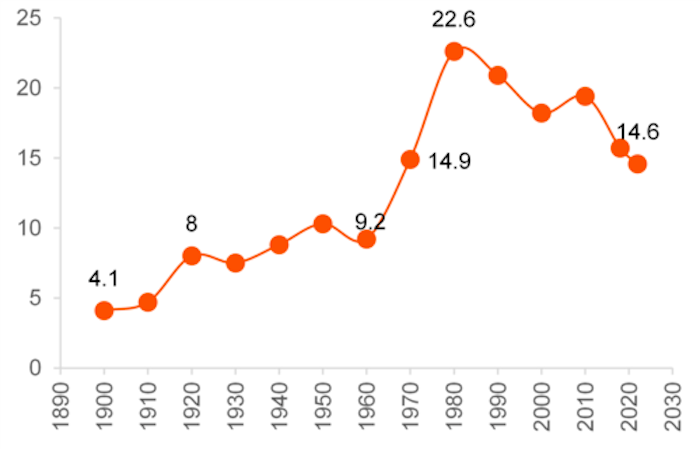Get PolitiFact in your inbox.

Then-President elect Ronald Reagan and wife Nancy wave to a crowd of onlookers upon their arrival at the Palm Springs, Calif., airport in November 1980. Reagan signed the first no-fault divorce law in 1969 when he was California's governor. (AP)
Within hours of President-elect Donald Trump winning the 2024 election, women took to social media with a warning: If you’re in a broken marriage, get out now.
They said divorce laws would change once Trump is in office, citing the Project 2025 conservative policy document for the next Republican administration.
"If you are a woman in the United States who is currently in an unhappy or miserable or abusive marriage, please do whatever you have to do to get divorced before 1/20/25," one Nov. 6 Threads post said.
"Project 2025 is getting rid of no fault divorce," another Threads post warned. "If a woman wants a divorce for whatever reason … and the husband doesn’t … no divorce. This will keep women trapped in violent marriages. But … that’s the point."
No-fault divorce is a legal process that allows a couple to end a marriage without proving one person’s behavior is to blame. It is allowed in all 50 U.S. states.
There is a movement at the state level among some Republican lawmakers to end no-fault divorce. House Speaker Mike Johnson, R-La., and Vice President-elect JD Vance have criticized it in the past.
But the push to make divorce more difficult is more limited than viral social media posts describe. It is not connected to a federal effort led by Trump, and it is not outlined as a Project 2025 policy recommendation.
"I certainly think it's possible. It’s a legitimate worry. But this isn’t going to happen in one day," said Marcia Zug, a family law professor at the Rice School of Law at the University of South Carolina. "The idea that (a no-fault divorce) has to be done before Trump becomes president; it's not really related to that."
Zug said people seem to be connecting this to Roe v. Wade, and how Trump was able to appoint three justices to the U.S. Supreme Court who helped overturn the landmark ruling in 2022. Unlike the Roe precedent, there’s no federal right to divorce that Trump could try to eliminate, and Congress is unlikely to pass a federal ban.
This is a states issue. State laws vary on how long no-fault divorce takes, with some requiring separations of a year or more before a divorce is granted. Although some southern red states have proposed legislation that would end or restrict no-fault divorce, none has come close to passing.
"What is a realistic fear," Zug said, "is that this is something that no one was discussing a few years ago. It was not a consideration and now increasingly it is. It went from fringe talk show host ideas to being proposed in new state legislation, and that’s something worth paying attention to."
How no-fault divorce became the law of the land
California was the first state to enact no-fault divorce in 1970 after then-Gov. Ronald Reagan signed it into law. Reagan, himself a divorcé, said the law was a step toward removing the "acrimony and bitterness between a couple that is harmful not only to their children but also to society as a whole."
"Before 1970, fault-based divorce was the only way to get out of marriage, and it required that the person wanting to exit proved that their spouse committed some marital wrong: infidelity, desertion or cruelty were the most common," said Scott Altman, a University of Southern California family law professor whose research focuses on child custody and divorce disagreements.
Not only was fault-based divorce more acrimonious and expensive, Altman said, but couples often fabricated reasons for divorce, such as alleging infidelity that never happened. Lawmakers and the courts concluded that it was better to let people end their marriages for their own reasons.
Since 2010, all states have legalized a no-fault divorce option, though the processes, time frames and requirements differ. Incompatibility or irreconcilable differences are the most common reasons cited in these cases, and, in the majority of states, both parties do not have to agree for a marriage to be ended. Some states allow only no-fault divorces; others permit both options.
Some family law experts and women’s rights advocates say the at-fault system disproportionately affects women, particularly those in abusive relationships with few resources. To obtain an at-fault divorce, a woman in an abusive marriage would have to prove their husband’s abuse in court, a costly, emotionally draining and potentially dangerous process.
Studies have shown unilateral no-fault divorce — when one party can end a marriage — correlates with a reduction in female suicides and domestic violence.
What Republicans and Trump have said about it
For all of the concern about what Trump, empowered Republicans in Congress and Project 2025 could do about no-fault divorce, they have said little about it.
Trump, who divorced two women before marrying Melania Knauss in 2005, did not center no-fault divorce in his campaign and has not publicly spoken about it.
The idea does not appear on the Republican National Committee's 2024 platform.
And Project 2025 doesn’t propose ending no-fault divorce, contrary to the viral warnings.
So what’s going on?
Some organizations on Project 2025’s advisory board, such as the Center for Family and Human Rights and the Family Research Council, have separately criticized no-fault divorce or called for its elimination.
Johnson, the House speaker, has opposed no-fault divorce for years. He blamed it in 2016 for helping turn the U.S. into a "completely amoral society."
Louisiana, which has considered eliminating no-fault divorce, was the first state to pass a "covenant marriage" law, a religion-based contract married couples can choose that makes it significantly harder to get divorced. Johnson has a covenant marriage with his wife, joining about 1% of Louisiana couples.
Vance said in 2021 that people divorce too easily and called no-fault divorce "one of the great tricks that I think the sexual revolution pulled on the American populace."
At the state level, the Texas and Nebraska GOP platforms call for eradicating or restricting no-fault divorce. Other Republican-led states, such as Oklahoma and South Dakota, have introduced bills to end the framework.
Although these bills have failed so far, legal scholars said concerns over losing no-fault divorce have merit.
Nevertheless, this doesn’t appear to be a priority for the federal government. The Trump administration could encourage states with federal money to advance anti-no-fault divorce laws, but legal scholars don’t see that as likely.
Some opponents of the no-fault divorce movement argue the practice weakens marriage by driving up the divorce rate and takes the benefits of a two-parent household away from children.
This is a topic of continuing study. Family law experts told PolitiFact that the weight of evidence shows no-fault divorce appears to have had little effect on the divorce rate. Statistics show that an initial spike in divorce rates occurred once states started adopting no-fault divorce, but this happened during a time of already-rising divorce rates. The numbers have evened out, and in some cases dropped, over time.
Sources: NCFMR analyses of data from the National Vital Statistics, CDC/NCHS, 1900-2000; U.S. Census Bureau 2000 Decennial Census; U.S. Census Bureau (IPUMS), American Community Survey, 2010 and 2022 (IPUMS). Credit: Bowling Green State University.
"Divorce rates were moving up systemically in all states before no-fault divorce, and it's been followed up by a steady level since then," said Altman of USC. "It was part of a basic trend in society that happened simultaneously with the no-fault divorce movement, but wasn’t caused or exacerbated by it."
Census data from 2020 found that the divorce rate hit a 50-year low in 2019 and remained near a record low in data released in 2021. This also coincided with a decline in the marriage rate.
A split household’s effect on children, meanwhile, varies widely based on the situation. Children with divorced parents are often better off than in an unsafe or emotionally turbulent home, family law experts said, but it’s less clear in homes with slightly unhappy parents.
Other experts pointed out that no-fault divorce isn’t as easy as some make it out to be. It takes resources and time.
"I don't think most people get divorced without thinking about it, and with a no-fault divorce it's not like you can do it tomorrow. Different states have different requirements," Zug said. "And when you talk to people who are getting divorced most of them have thought long and hard before they file; it’s really not on a whim."
RELATED: Ask PolitiFact: What are Donald Trump’s second-term plans for the economy, immigration, abortion?
Our Sources
Threads post, Nov. 6, 2024
Threads post, Nov. 9, 2024
The Los Angeles Times, California settled the no-fault divorce question decades ago. Why is it back in the news?, May 24, 2024
Southern Denver Law, Divorce in No-Fault States, Accessed Nov. 14, 2024
National Council on Family Relations, The Effective Dates of No-Fault Divorce Laws in the 50 States*, Accessed Nov. 14, 2024
National Bureau of Economic Research, BARGAINING IN THE SHADOW OF THE LAW: DIVORCE LAWS AND FAMILY DISTRESS, 2003
Bowling Green State University, Divorce: More than a Century of Change, 1900-2022, Nov. 11, 2024
Time magazine, The Right Aims to Turn Back the Clock on American Divorce Law, July 23, 2024
The Washington Post, Women fear Republicans will move to overturn no-fault divorce laws, Nov. 9, 2024
Mother Jones, The Most Powerful Man in the House Doesn’t Like Divorce, Oct. 26, 2023
CNN, What is no-fault divorce, and why do some conservatives want to get rid of it?, Nov. 27, 2023
PBS, Some conservative lawmakers want to end no-fault divorce. Here’s why, July 20, 2024
WWNO, New Orleans Public Radio,Louisiana Republican Party considers backing elimination of no-fault divorce, Jan. 12, 2023
The Los Angeles Times, At O.C. event, JD Vance said divorces after unhappy, ‘even violent’ marriages ‘didn’t work out for the kids’, Aug. 9, 2024
Texas GOP, 2024 Platform and Resolutions of the Republican Party of Texas, Accessed Nov. 15, 2024
Nebraska GOP, Family, Accessed Nov. 15, 2024
The Oklahoman, New Oklahoma senator files bill that would end no-fault divorces in the state, Jan. 26, 2024
Ankler Law, Proposed Bill Would Eliminate Irreconcilable Differences as a Ground for Divorce in South Dakota, March 3, 2020
Institute for Family Studies, The U.S. Divorce Rate Has Hit a 50-Year Low, Nov. 10, 2020
Forbes, Revealing Divorce Statistics In 2024, Oct. 16, 2024
Census.gov, Is Your State in Step with National Marriage and Divorce Trends?, July 13, 2023
Phone interview, Scott Altman, family law professor at USC Gould School of Law, Nov. 14, 2024
Phone interview, Marcia A. Zug, family law professor at the Rice School of Law at the University of South Carolina, Nov. 14, 2024
Email interview, Margaret Ryznar, visiting professor at Brooklyn Law School and editor emeritus of the Family Law Blog, Nov. 15, 2024
Email interview, Monica Hof Wallace, law professor Loyola University New Orleans, Nov. 14, 2024
Email interview, Shanta Trivedi, assistant law professor at the University of Baltimore, Nov. 15, 2024













































